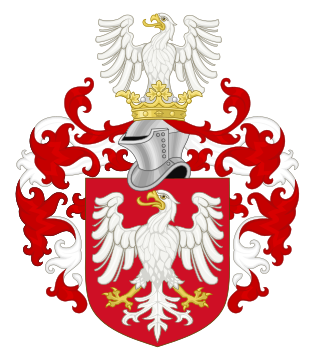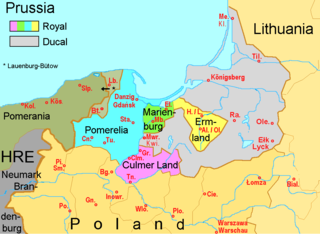
The House of Piast was the first historical ruling dynasty of Poland. The first documented Polish monarch was Duke Mieszko I. The Piasts' royal rule in Poland ended in 1370 with the death of King Casimir III the Great.

Władysław I Łokietek, in English known as the "Elbow-high" or Ladislaus the Short, was King of Poland from 1320 to 1333, and duke of several of the provinces and principalities in the preceding years. He was a member of the royal Piast dynasty, the son of Duke Casimir I of Kuyavia, and great-grandson of High-Duke Casimir II the Just.

Pomerelia, also known as Eastern Pomerania, Vistula Pomerania, and also before World War II as Polish Pomerania, is a historical sub-region of Pomerania on the southern shore of the Baltic Sea in northern Poland.

The Duchy of Greater Poland was a district principality in Greater Poland that was a fiefdom of the Kingdom of Poland. It was formed in 1138 from the territories of the Kingdom of Poland, following its fragmentation started by the testament of Bolesław III Wrymouth. In 1177, the state broke had separated into the duchies of Poznań, Gniezno and Kalisz, and united again in 1279, lasting in that form until 1320, when it was incorporated back into the Kingdom of Poland. Its capital was Poznań.

Bolesław the Pious was a Duke of Greater Poland during 1239–1247, Duke of Kalisz during 1247–1249, Duke of Gniezno during 1249–1250, Duke of Gniezno-Kalisz during 1253–1257, Duke of the whole of Greater Poland and Poznań during 1257–1273, in 1261 ruler over Ląd, regent of the Duchies of Mazovia, Płock and Czersk during 1262–1264, ruler over Bydgoszcz during 1268–1273, Duke of Inowrocław during 1271–1273, and Duke of Gniezno-Kalisz from 1273 until his death.
Mestwin II was a Duke of Pomerelia, member of the Samborides dynasty. He ruled Pomerelia as a sole ruler from 1273 to 1294.

The Treaty of Kalisz was a peace treaty signed on 8 July 1343 in Kalisz, concluded by the Kingdom of Poland under King Casimir III the Great and the State of the Teutonic Order under Grand Master of the Teutonic Order Ludolf König von Wattzau.

Dobrzyń Land is a historical region in central-northern Poland. It lies northeast of the Vistula River, south of the Drwęca, and west of the Skrwa. The territory approximately corresponds with the present-day powiats of Lipno, Rypin, and half of Golub-Dobrzyń within the Kuyavian-Pomeranian Voivodeship, although it encompasses parts of other counties as well. Totally, it has about 3,000 km2 and 200,000 inhabitants. Its historic capital is Dobrzyń nad Wisłą, which gave its name to the entire region. Its largest town is Rypin.
Werner von Orseln was the 17th Grand Master of the Teutonic Order from 1324 until his murder in 1330.

The Duchy of Pomerelia, also known as the Duchy of Eastern Pomerania, and Gdańsk Pomerania was a duchy centred on Pomerelia, with Gdańsk as its capital.

The Samborides or House of Sobiesław were a ruling dynasty in the historic region of Pomerelia. They were first documented about 1155 as governors (princeps) in the Eastern Pomeranian lands serving the royal Piast dynasty of Poland, and from 1227 ruled as autonomous princes until 1294, at which time the dynasty died out. The subsequent war for succession between the Polish Piast dynasty, the Imperial Margraviate of Brandenburg and the State of the Teutonic Order resulted in the Teutonic takeover of Gdańsk (Danzig) in 1308.

Lauenburg and Bütow Land formed a historical region in the western part of Pomerelia or in the eastern part of Farther Pomerania. It was composed of two districts centered on the towns of Lauenburg (Lębork) and Bütow (Bytów). The land is today part of the Polish Pomeranian Voivodeship.

Polish–Teutonic Wars refer to a series of conflicts that took place between the Kingdom of Poland and the Teutonic Order, a medieval German military order with roots in the Baltic region. These wars occurred primarily during the 14th and 15th centuries and were characterized by territorial disputes, political maneuvering, and religious differences.

The Treaty of Namslau or Namysłów, also known as the Peace of Namslau/Namysłów, was a peace treaty between King Charles IV of Bohemia and King Casimir III of Poland. It was signed at Namysłów in Silesia, on 22 November 1348 after the Polish-Bohemian War of 1345–1348.

The Treaty of Trencin was concluded on 24 August 1335 between King Casimir III of Poland and King John of Bohemia together with his son Margrave Charles IV. The agreement was reached by the agency of Casimir's brother-in-law King Charles I of Hungary and signed at Trencin Castle in the Kingdom of Hungary. It initiated the transfer of suzerainty over the former Polish province of Silesia to the Kingdom of Bohemia, whereafter the Duchies of Silesia were incorporated into the Bohemian Crown. Following the integration of this treaty, the three kingdoms of Bohemia, Hungary, and Poland met at the First Congress of Visegrad later in 1335 to further discuss the division of land. This congress also made the treaty official.

The Schlawe and Stolp Land, also known as Słupsk and Sławno Land, is a historical region in Pomerania, centered on the towns of Sławno (Schlawe) and Słupsk (Stolp) in Farther Pomerania, in present-day Poland.

Duchy of Kraków was a duchy in Lesser Poland that existed from 1227 until 1300. Its capital was Kraków. It was formed in 1227 from the Seniorate Province, following the abolishment of the Duchy of Poland. It remained independent until 1300, when it had become a fiefdom within the Kingdom of Poland. In 1320, it was incorporated into the United Kingdom of Poland.

Leszek of Inowrocław, was a Polish prince member of the House of Piast. He was Duke of Inowrocław from 1287 to 1314, Duke of Pomerelia in 1296, and ruler over Wyszogród from 1296. In 1300 he paid homage to King Wenceslaus II of Bohemia, in 1303 sold to the Teutonic Order the Michałów Land, during 1303–1312 in captivity in Bohemia, since 1312 vassal of the Kingdom of Poland, during 1314-1320/24 sole ruler over Inowrocław, abdicated.

Przemysł of Inowrocław, was a Polish prince member of the House of Piast, Duke of Inowrocław during 1287-1314, after 1300 vassal of King Wenceslaus II of Bohemia, Duke of Dobrzyń during 1303-1305, after 1306 vassal of the Kingdom of Poland, Governor of the Duchy of Pomerelia during 1306-1309, after 1314 ruler over Bydgoszcz and Wyszogród, Duke of Inowrocław after 1320/24, in 1327 he exchange Inowrocław for Sieradz.

The Duchy of Brześć Kujawski, also known as the Duchy of Kuyavian Brest, was a district principality in the Central Europe, in the region of Kuyavia. Its capital was Brześć Kujawski. It was formed on 3 January 1268 in the partition of the Duchy of Kuyavia. Its first ruler was duke Władysław I Łokietek of the Piast dynasty. The state was conquered by the State of the Teutonic Order in 1332, during Polish–Teutonic War, with its capitol being captured on 21 April. Until 1300, it was an independent state, after what, it had become a fiefdom within the Kingdom of Poland, that in 1320, got transformed into the United Kingdom of Poland.


















